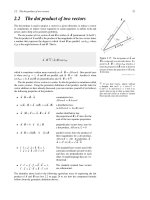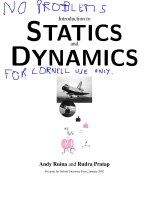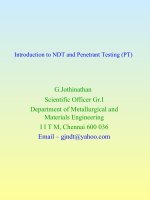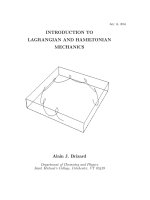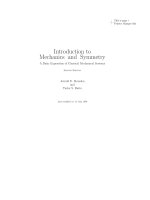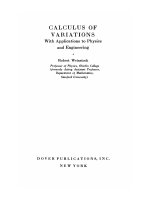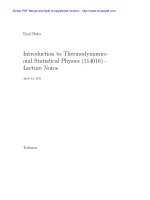- Trang chủ >>
- Khoa Học Tự Nhiên >>
- Vật lý
Joachim piprek semiconductor optoelectronic devices introduction to physics and simulation academic press (2003)
Bạn đang xem bản rút gọn của tài liệu. Xem và tải ngay bản đầy đủ của tài liệu tại đây (4.41 MB, 296 trang )
Semiconductor
Optoelectronic Devices
Introduction to Physics
and Simulation
www.pdfgrip.com
www.pdfgrip.com
Semiconductor
Optoelectronic Devices
Introduction to Physics
and Simulation
JOACHIM PIPREK
University of California
at Santa Barbara
Amsterdam
San Diego
Boston
London New York Oxford Paris
San Francisco
Singapore Sydney Tokyo
www.pdfgrip.com
This book is printed on acid-free paper.
Copyright 2003, Elsevier Science (USA)
All rights reserved.
No part of this publication may be reproduced or transmitted in any form or by any
means, electronic or mechanical, including photocopy, recording or any information
storage and retrieval system, without permission in writing from the publisher.
Permissions may be sought directly from Elsevier’s Science & Technology Rights
Department in Oxford, UK: phone: (+44) 1865 843830, fax: (+44) 1865 853333,
e-mail: You may also complete your request on-line
via the Elsevier Science homepage (), by selecting
“Customer Support” and then “Obtaining Permissions.”
Academic Press
An imprint of Elsevier Science
525 B Street, Suite 1900, San Diego, California 92101-4495, USA
Academic Press
84 Theobald’s Road, London WC1X 8RR, UK
Library of Congress Control Number: 2002111026
International Standard Book Number: 0-12-557190-9
PRINTED IN THE UNITED STATES OF AMERICA
02 03 04 05 06
9 8 7 6 5 4 3 2
1
www.pdfgrip.com
To Lisa
www.pdfgrip.com
www.pdfgrip.com
Contents
Preface
xi
List of Tables
xiii
I
Fundamentals
1
1
Introduction to Semiconductors
1.1 Electrons, Holes, Photons, and Phonons . . . . . . . . . . . . . .
1.2 Fermi distribution and density of states . . . . . . . . . . . . . . .
1.3 Doping . . . . . . . . . . . . . . . . . . . . . . . . . . . . . . .
3
3
5
7
2
Electron energy bands
2.1 Fundamentals . . . . . . . . . . . . . . . . . . . . .
2.1.1 Electron Waves . . . . . . . . . . . . . . . .
2.1.2 Effective Mass of Electrons and Holes . . . .
2.1.3 Energy Band Gap . . . . . . . . . . . . . . .
2.2 Electronic Band Structure: The k · p Method . . . . .
2.2.1 Two-Band Model (Zinc Blende) . . . . . . .
2.2.2 Strain Effects (Zinc Blende) . . . . . . . . .
2.2.3 Three- and Four-Band Models (Zinc Blende)
2.2.4 Three-Band Model for Wurtzite Crystals . . .
2.3 Quantum Wells . . . . . . . . . . . . . . . . . . . .
2.4 Semiconductor Alloys . . . . . . . . . . . . . . . . .
2.5 Band Offset at Heterointerfaces . . . . . . . . . . . .
.
.
.
.
.
.
.
.
.
.
.
.
.
.
.
.
.
.
.
.
.
.
.
.
.
.
.
.
.
.
.
.
.
.
.
.
.
.
.
.
.
.
.
.
.
.
.
.
.
.
.
.
.
.
.
.
.
.
.
.
.
.
.
.
.
.
.
.
.
.
.
.
.
.
.
.
.
.
.
.
.
.
.
.
13
13
13
16
20
23
24
27
30
32
39
43
43
Carrier transport
3.1 Drift and Diffusion . . . . . . . . . . . .
3.2 pn-Junctions . . . . . . . . . . . . . . .
3.3 Heterojunctions . . . . . . . . . . . . . .
3.4 Tunneling . . . . . . . . . . . . . . . . .
3.5 Boundary Conditions . . . . . . . . . . .
3.5.1 Insulator–Semiconductor Interface
3.5.2 Metal–Semiconductor Contact . .
.
.
.
.
.
.
.
.
.
.
.
.
.
.
.
.
.
.
.
.
.
.
.
.
.
.
.
.
.
.
.
.
.
.
.
.
.
.
.
.
.
.
.
.
.
.
.
.
.
49
49
50
51
54
56
57
58
3
vii
www.pdfgrip.com
.
.
.
.
.
.
.
.
.
.
.
.
.
.
.
.
.
.
.
.
.
.
.
.
.
.
.
.
.
.
.
.
.
.
.
.
.
.
.
.
.
.
viii
CONTENTS
3.6
3.7
Carrier Mobility . . . . . . . . . . . .
Electron–Hole Recombination . . . .
3.7.1 Radiative Recombination . . .
3.7.2 Nonradiative Recombination .
3.8 Electron–Hole Generation . . . . . .
3.8.1 Photon Absorption . . . . . .
3.8.2 Impact Ionization . . . . . . .
3.8.3 Band-to-Band Tunneling . . .
3.9 Advanced Transport Models . . . . .
3.9.1 Energy Balance Model . . . .
3.9.2 Boltzmann Transport Equation
4
5
6
.
.
.
.
.
.
.
.
.
.
.
.
.
.
.
.
.
.
.
.
.
.
.
.
.
.
.
.
.
.
.
.
.
.
.
.
.
.
.
.
.
.
.
.
.
.
.
.
.
.
.
.
.
.
.
.
.
.
.
.
.
.
.
.
.
.
.
.
.
.
.
.
.
.
.
.
.
.
.
.
.
.
.
.
.
.
.
.
.
.
.
.
.
.
.
.
.
.
.
.
.
.
.
.
.
.
.
.
.
.
.
.
.
.
.
.
.
.
.
.
.
.
.
.
.
.
.
.
.
.
.
.
.
.
.
.
.
.
.
.
.
.
.
.
.
.
.
.
.
.
.
.
.
.
.
.
.
.
.
.
.
.
.
.
.
61
67
67
68
71
71
72
76
78
78
81
Optical Waves
4.1 Maxwell’s Equations . . . . . . . . .
4.2 Dielectric Function . . . . . . . . . .
4.2.1 Absorption Coefficient . . . .
4.2.2 Index of Refraction . . . . . .
4.3 Boundary Conditions . . . . . . . . .
4.4 Plane Waves . . . . . . . . . . . . . .
4.5 Plane Waves at Interfaces . . . . . . .
4.6 Multilayer Structures . . . . . . . . .
4.7 HelmholtzWave Equations . . . . . .
4.8 Symmetric Planar Waveguides . . . .
4.9 Rectangular Waveguides . . . . . . .
4.10 Facet Reflection of Waveguide Modes
4.11 Periodic Structures . . . . . . . . . .
4.12 Gaussian Beams . . . . . . . . . . . .
4.13 Far Field . . . . . . . . . . . . . . . .
.
.
.
.
.
.
.
.
.
.
.
.
.
.
.
.
.
.
.
.
.
.
.
.
.
.
.
.
.
.
.
.
.
.
.
.
.
.
.
.
.
.
.
.
.
.
.
.
.
.
.
.
.
.
.
.
.
.
.
.
.
.
.
.
.
.
.
.
.
.
.
.
.
.
.
.
.
.
.
.
.
.
.
.
.
.
.
.
.
.
.
.
.
.
.
.
.
.
.
.
.
.
.
.
.
.
.
.
.
.
.
.
.
.
.
.
.
.
.
.
.
.
.
.
.
.
.
.
.
.
.
.
.
.
.
.
.
.
.
.
.
.
.
.
.
.
.
.
.
.
.
.
.
.
.
.
.
.
.
.
.
.
.
.
.
.
.
.
.
.
.
.
.
.
.
.
.
.
.
.
.
.
.
.
.
.
.
.
.
.
.
.
.
.
.
.
.
.
.
.
.
.
.
.
.
.
.
.
.
.
.
.
.
.
.
.
.
.
.
.
.
.
.
.
.
83
83
85
87
91
94
95
97
101
102
104
108
110
112
114
116
Photon Generation
5.1 Optical Gain . . . . . . . . . . . . . .
5.1.1 Transition Matrix Element . .
5.1.2 Transition Energy Broadening
5.1.3 Strain Effects . . . . . . . . .
5.1.4 Many-Body Effects . . . . . .
5.1.5 Gain Suppression . . . . . . .
5.2 Spontaneous Emission . . . . . . . .
.
.
.
.
.
.
.
.
.
.
.
.
.
.
.
.
.
.
.
.
.
.
.
.
.
.
.
.
.
.
.
.
.
.
.
.
.
.
.
.
.
.
.
.
.
.
.
.
.
.
.
.
.
.
.
.
.
.
.
.
.
.
.
.
.
.
.
.
.
.
.
.
.
.
.
.
.
.
.
.
.
.
.
.
.
.
.
.
.
.
.
.
.
.
.
.
.
.
.
.
.
.
.
.
.
121
121
124
127
131
135
135
136
Heat Generation and Dissipation
141
6.1 Heat Flux Equation . . . . . . . . . . . . . . . . . . . . . . . . . 141
www.pdfgrip.com
ix
CONTENTS
6.2
6.3
6.4
II
7
Heat Generation . . . . . . . . .
6.2.1 Joule Heat . . . . . . . .
6.2.2 Recombination Heat . .
6.2.3 Thomson Heat . . . . . .
6.2.4 Optical Absorption Heat
Thermal Resistance . . . . . . .
Boundary Conditions . . . . . .
.
.
.
.
.
.
.
.
.
.
.
.
.
.
.
.
.
.
.
.
.
.
.
.
.
.
.
.
.
.
.
.
.
.
.
.
.
.
.
.
.
.
.
.
.
.
.
.
.
.
.
.
.
.
.
.
.
.
.
.
.
.
.
.
.
.
.
.
.
.
.
.
.
.
.
.
.
.
.
.
.
.
.
.
.
.
.
.
.
.
.
.
.
.
.
.
.
.
.
.
.
.
.
.
.
.
.
.
.
.
.
.
.
.
.
.
.
.
.
Devices
145
145
145
146
146
147
147
149
Edge-Emitting Laser
7.1 Introduction . . . . . . . . . . . . . . . . .
7.2 Models and Material Parameters . . . . . .
7.2.1 Drift–Diffusion Model . . . . . . .
7.2.2 Gain Model . . . . . . . . . . . . .
7.2.3 Optical Model . . . . . . . . . . . .
7.3 Cavity Length Effects on Loss Parameters .
7.4 Slope Efficiency Limitations . . . . . . . .
7.5 Temperature Effects on Laser Performance .
8 Vertical-Cavity Laser
8.1 Introduction . . . . . . . . . . . . . . .
8.2 Long-Wavelength Vertical-Cavity Lasers
8.3 Model and Parameters . . . . . . . . .
8.4 Carrier Transport Effects . . . . . . . .
8.5 Thermal Analysis . . . . . . . . . . . .
8.6 Optical Simulation . . . . . . . . . . .
8.7 Temperature Effects on the Optical Gain
9
.
.
.
.
.
.
.
Nitride Light Emitters
9.1 Introduction . . . . . . . . . . . .
9.2 Nitride Material Properties . . . .
9.2.1 Carrier Transport . . . . .
9.2.2 Energy Bands . . . . . . .
9.2.3 Polarization . . . . . . . .
9.2.4 Refractive Index . . . . . .
9.2.5 Thermal Conductivity . . .
9.3 InGaN/GaN Light-Emitting Diode
9.3.1 Device Structure . . . . .
9.3.2 Polarization Effects . . . .
.
.
.
.
.
.
.
.
.
.
.
.
.
.
.
.
.
.
.
.
.
.
.
.
.
.
.
.
.
.
www.pdfgrip.com
.
.
.
.
.
.
.
.
.
.
.
.
.
.
.
.
.
.
.
.
.
.
.
.
.
.
.
.
.
.
.
.
.
.
.
.
.
.
.
.
.
.
.
.
.
.
.
.
.
.
.
.
.
.
.
.
.
.
.
.
.
.
.
.
.
.
.
.
.
.
.
.
.
.
.
.
.
.
.
.
.
.
.
.
.
.
.
.
.
.
.
.
.
.
.
.
151
151
156
157
158
158
161
162
164
.
.
.
.
.
.
.
.
.
.
.
.
.
.
.
.
.
.
.
.
.
.
.
.
.
.
.
.
.
.
.
.
.
.
.
.
.
.
.
.
.
.
.
.
.
.
.
.
.
.
.
.
.
.
.
.
.
.
.
.
.
.
.
.
.
.
.
.
.
.
.
.
.
.
.
.
.
.
.
.
.
.
.
.
.
.
.
.
.
.
.
.
.
.
.
.
.
.
171
171
171
174
175
178
181
184
.
.
.
.
.
.
.
.
.
.
.
.
.
.
.
.
.
.
.
.
.
.
.
.
.
.
.
.
.
.
.
.
.
.
.
.
.
.
.
.
.
.
.
.
.
.
.
.
.
.
.
.
.
.
.
.
.
.
.
.
.
.
.
.
.
.
.
.
.
.
.
.
.
.
.
.
.
.
.
.
.
.
.
.
.
.
.
.
.
.
.
.
.
.
.
.
.
.
.
.
.
.
.
.
.
.
.
.
.
.
.
.
.
.
.
.
.
.
.
.
.
.
.
.
.
.
.
.
.
.
.
.
.
.
.
.
.
.
.
.
187
187
188
188
191
192
194
195
196
196
197
x
CONTENTS
.
.
.
.
.
.
.
.
.
.
.
.
.
.
.
.
.
.
.
.
.
.
.
.
.
.
.
.
.
.
.
.
.
.
.
.
.
.
.
.
.
.
.
.
.
.
.
.
.
.
.
.
.
.
.
.
.
.
.
.
.
.
.
.
.
.
.
.
.
.
.
.
.
.
.
.
.
.
.
.
.
.
.
.
.
.
.
.
.
.
.
.
.
.
.
.
.
.
.
.
.
.
.
.
.
.
.
.
.
.
.
.
.
.
.
.
.
.
.
.
198
200
204
204
204
205
208
210
.
.
.
.
.
.
.
.
.
.
.
.
.
.
.
.
.
.
.
.
.
.
.
.
.
.
.
.
.
.
.
.
.
.
.
.
.
.
.
.
.
.
.
.
.
.
.
.
.
.
.
.
.
.
.
.
.
.
.
.
213
213
214
217
220
11 Amplification Photodetector
11.1 Introduction . . . . . . . . . . . . . . .
11.2 Device Structure and Material Properties
11.3 Waveguide Mode Analysis . . . . . . .
11.4 Detector Responsivity . . . . . . . . . .
.
.
.
.
.
.
.
.
.
.
.
.
.
.
.
.
.
.
.
.
.
.
.
.
.
.
.
.
.
.
.
.
.
.
.
.
.
.
.
.
.
.
.
.
.
.
.
.
.
.
.
.
.
.
.
.
227
227
228
232
234
9.4
9.3.3 Current Crowding . . . . . . .
9.3.4 Quantum Efficiency . . . . . .
InGaN/GaN Laser Diode . . . . . . .
9.4.1 Device Structure . . . . . . .
9.4.2 Optical Gain . . . . . . . . . .
9.4.3 Comparison to Measurements
9.4.4 Power Limitations . . . . . . .
9.4.5 Performance Optimization . .
10 Electroabsorption Modulator
10.1 Introduction . . . . . . . . . . . .
10.2 Multiquantum Well Active Region
10.3 Optical Waveguide . . . . . . . .
10.4 Transmission Analysis . . . . . .
.
.
.
.
.
.
.
.
A Constants and Units
237
A.1 Physical Constants . . . . . . . . . . . . . . . . . . . . . . . . . 237
A.2 Unit Conversion . . . . . . . . . . . . . . . . . . . . . . . . . . . 237
B Basic Mathematical Relations
B.1 Coordinate Systems . . . .
B.2 Vector and Matrix Analysis
B.3 Complex Numbers . . . .
B.4 Bessel Functions . . . . .
B.5 Fourier Transformation . .
.
.
.
.
.
.
.
.
.
.
.
.
.
.
.
.
.
.
.
.
.
.
.
.
.
.
.
.
.
.
.
.
.
.
.
C Symbols and Abbreviations
.
.
.
.
.
.
.
.
.
.
.
.
.
.
.
.
.
.
.
.
.
.
.
.
.
.
.
.
.
.
.
.
.
.
.
.
.
.
.
.
.
.
.
.
.
.
.
.
.
.
.
.
.
.
.
.
.
.
.
.
.
.
.
.
.
.
.
.
.
.
239
239
240
241
242
243
245
Bibliography
251
Index
273
www.pdfgrip.com
Preface
Optoelectronics has become an important part of our lives. Wherever light is used
to transmit information, tiny semiconductor devices are needed to transfer electrical current into optical signals and vice versa. Examples include light-emitting
diodes in radios and other appliances, photodetectors in elevator doors and digital cameras, and laser diodes that transmit phone calls through glass fibers. Such
optoelectronic devices take advantage of sophisticated interactions between electrons and light. Nanometer scale semiconductor structures are often at the heart
of modern optoelectronic devices. Their shrinking size and increasing complexity
make computer simulation an important tool for designing better devices that meet
ever-rising performance requirements. The current need to apply advanced design
software in optoelectronics follows the trend observed in the 1980s with simulation software for silicon devices. Today, software for technology computer-aided
design (TCAD) and electronic design automation (EDA) represents a fundamental part of the silicon industry. In optoelectronics, advanced commercial device
software has emerged, and it is expected to play an increasingly important role in
the near future.
The target audience of this book is students, engineers, and researchers who
are interested in using high-end software tools to design and analyze semiconductor optoelectronic devices. The first part of the book provides fundamental
knowledge in semiconductor physics and in waveguide optics. Optoelectronics
combines electronics and photonics and the book addresses readers approaching
the field from either side. The text is written at an introductory level, requiring
only a basic background in solid state physics and optics. Material properties and
corresponding mathematical models are covered for a wide selection of semiconductors used in optoelectronics. The second part of the book investigates
modern optoelectronic devices, including light-emitting diodes, edge-emitting
lasers, vertical-cavity lasers, electroabsorption modulators, and a novel combination of amplifier and photodetector. InP-, GaAs-, and GaN-based devices are
analyzed. The calibration of model parameters using available measurements is
emphasized in order to obtain realistic results. These real-world simulation examples give new insight into device physics that is hard to gain without numerical
modeling. Most simulations in this book employ the commercial software suite
developed by Crosslight Software, Inc. (APSYS, LASTIP, PICS3D). Interested
readers can obtain a free trial version of this software including example input
files on the Internet at .
xi
www.pdfgrip.com
xii
PREFACE
I would like to thank all my students in Germany, Sweden, Great Britain,
Taiwan, Canada, and the United States, for their interest in this field and for all
their questions, which eventually motivated me to write this book. I am grateful
to Dr. Simon Li for creating the Crosslight software suite and for supporting my
work. Prof. John Bowers gave me the opportunity to participate in several leading
edge research projects, which provided some of the device examples in this book.
I am also thankful to Prof. Shuji Nakamura for valuable discussions on the nitride
devices. Parts of the manuscript have been reviewed by colleagues and friends, and
I would like to acknowledge helpful comments from Dr. Justin Hodiak, Dr. Monica
Hansen, Dr. Hans-Jürgen Wünsche, Daniel Lasaosa, Dr. Donato Pasquariello, and
Dr. Lisa Chieffo. I appreciate especially the extensive suggestions I received from
Dr. Hans Wenzel who carefully reviewed part I of the book.
Writing this book was part of my ongoing commitment to build bridges between
theoretical and experimental research. I encourage readers to send comments by
e-mail to and I will continue to provide additional help and
information at my web site />Joachim Piprek
Santa Barbara, California
www.pdfgrip.com
List of Tables
1.1
2.1
2.2
2.3
2.4
2.5
2.6
2.7
2.8
2.9
3.1
3.2
3.2
Energy Band Gap Eg , Density-of-States Effective Masses mc and
mv , Effective Densities of States Nc and Nv , and Intrinsic Carrier
Concentration ni at Room Temperature [1, 2, 3, 4, 5, 6, 7] . . . . .
Electron Effective Masses mc in Units of m0 for Conduction Band
Minima in Cubic Semiconductors at Low Temperatures [2, 13] .
Hole Effective Masses in Units of m0 for the Heavy-Hole Band
(mhh ), the Light-Hole Band (mlh ), and the Split-Off Band (mso ) at
Room Temperature [1, 2, 4, 5, 6] . . . . . . . . . . . . . . . . .
Energy Band Gaps at T = 0 K and Varshni Parameters of
Eq. (2.10) [2, 13, 15] . . . . . . . . . . . . . . . . . . . . . . .
Fundamental Energy Band Gap at T = 0 K (Type Given in
Parentheses) and Pässler Parameters of Eq. (2.11) for Cubic
Semiconductors [16] . . . . . . . . . . . . . . . . . . . . . . .
Luttinger Parameters γ for Cubic Semiconductors at Low Temperatures [2, 13] . . . . . . . . . . . . . . . . . . . . . . . . . .
Lattice Constant a0 , Thermal Expansion Coefficient da0 /dT ,
Elastic Stiffness Constants C11 and C12 , and Deformation Potentials b, av , ac for Cubic Semiconductors at Room Temperature
[1, 2, 13, 23] . . . . . . . . . . . . . . . . . . . . . . . . . . . .
Electron Band-Structure Parameters for Nitride Wurtzite Semiconductors at Room Temperature [13, 16, 29, 31, 32, 33, 34, 35,
36, 37, 38] . . . . . . . . . . . . . . . . . . . . . . . . . . . . .
Bowing Parameter in Eq. (2.108) for Energy Gaps Eg , EgX , EgL ,
Valence Band Edge Ev0 , and Spin–Orbit Splitting 0 at Room
Temperature [13, 42, 43] . . . . . . . . . . . . . . . . . . . . .
Valence Band Edge Reference Level Ev0 [13], Split-Off Energy 0
0
[13, 23], Average Valence Band Energy Ev,av
[23], and Electron
Affinity χ0 [46] for Unstrained Cubic Semiconductors . . . . . .
8
. 18
. 21
. 22
. 23
. 25
. 29
. 35
. 44
. 47
Work functions M of Selected Metals in Electron Volts (eV) [55] 59
Mobility Model Parameters of Eqs. (3.27) and (3.28) at Room
Temperature . . . . . . . . . . . . . . . . . . . . . . . . . . . . . 63
(Continued ) . . . . . . . . . . . . . . . . . . . . . . . . . . . . . 64
xiii
www.pdfgrip.com
xiv
LIST OF TABLES
3.3
3.4
3.5
3.6
4.1
4.2
4.3
Parameters for High-Field Mobility Models (Eqs. (3.29), (3.30),
and (3.31)) [4, 56, 68, 69] . . . . . . . . . . . . . . . . . . . .
Impact Ionization Parameters of Eq. (3.52) at Room Temperature
Impact Ionization Parameters of Eq. (3.53) at Room Temperature
[81] . . . . . . . . . . . . . . . . . . . . . . . . . . . . . . . .
Impact Ionization Parameters for Electrons: High-Field RoomTemperature Mean Free Path λn , Low-Temperature Optical
0 , and Ionization Threshold Energy E I [9] . .
Phonon Energy EOP
n
. 66
. 74
. 74
. 75
Parameters si and λi of the Sellmeier Refractive Index Model for
Undoped Semiconductors at Room Temperature (Eq. (4.28)) [104] 91
Parameters for the Simplified Adachi Model for the Refractive
Index below the Band Gap (hω
¯ < Eg ) as Given in Eqs. (4.31)
[43] and (4.34) [112, 120] . . . . . . . . . . . . . . . . . . . . . . 93
Static (εst ) and Optical (εopt ) Dielectric Constants, Reststrahlen
Wavelength λr [99], Band Gap Wavelength λg , Refractive Index
nr at Band Gap Wavelength, and Refractive Index Change with
Temperature . . . . . . . . . . . . . . . . . . . . . . . . . . . . . 94
5.1
Energy Parameter Ep of the Bulk Momentum Matrix Element Mb ,
Correction Factor Fb in Eqs. (5.5) and (2.61) [13], and Longitudinal Optical Phonon Energy hω
¯ LO [2, 89] as Used in the Asada
Scattering Model (Section 5.1.2) . . . . . . . . . . . . . . . . . . 125
6.1
Crystal Lattice Thermal Conductivity κL , Specific Heat CL , Density ρL , Debye Temperature D , and Temperature Coefficient δκ
at Room Temperature [1, 3, 6, 38, 46, 69] . . . . . . . . . . . . . 142
Thermal Conductivity Bowing Parameter CABC (Km/W) in
Eqs. (6.7), (6.8), and (6.9) for Ternary Alloys A(B,C) [43, 160] . . 144
6.2
7.1
Layer Materials and Room-Temperature Parameters of the MQW
Fabry–Perot Laser . . . . . . . . . . . . . . . . . . . . . . . . . . 155
8.1
Layer Materials and Parameters of the Double-Bonded VCSEL . . 173
9.1
Parameters for the High-Field Electron Mobility Function Given
in Eq. (9.2) [63] . . . . . . . . . . . . . . . . . . . . . . . . . .
Polarization Parameters for Nitride Materials [232] . . . . . . .
Layer Structure and Room-Temperature Parameters of the InGaN/
GaN LED . . . . . . . . . . . . . . . . . . . . . . . . . . . . .
Epitaxial Layer Structure and Room-Temperature Parameters of
the Nitride Laser . . . . . . . . . . . . . . . . . . . . . . . . .
9.2
9.3
9.4
www.pdfgrip.com
. 190
. 193
. 196
. 205
xv
LIST OF TABLES
10.1 Layer Structure and Parameters of the Electroabsorption Modulator with a Total of 10 Quantum Wells and 11 Barriers . . . . . . . 215
11.1 Epitaxial Layer Structure and Parameters of the Amplification
Photodetector . . . . . . . . . . . . . . . . . . . . . . . . . . . . 229
11.2 Optical Confinement Factors amp and det of the Vertical Modes
in Fig. 11.2 for the Amplification and Detection Layers,
Respectively . . . . . . . . . . . . . . . . . . . . . . . . . . . . . 233
www.pdfgrip.com
www.pdfgrip.com
Part I
Fundamentals
www.pdfgrip.com
www.pdfgrip.com
Chapter 1
Introduction to
Semiconductors
This chapter gives a brief introduction to semiconductors. Electrons and holes
are carriers of electrical current in semiconductors and they are separated by
an energy gap. Photons are the smallest energy packets of light waves and
their interaction with electrons is the key physical mechanism in optoelectronic devices. The internal temperature of the semiconductor depends on the
energy of lattice vibrations, which can be divided into phonons. The Fermi
distribution function for the electron energy and the density of electron states
are introduced.
1.1 Electrons, Holes, Photons, and Phonons
Optoelectronics brings together optics and electronics within a single device, a single material. The material of choice needs to allow for the manipulation of light, the
manipulation of electrical current, and their interaction. Metals are excellent electrical conductors, but do not allow light to travel inside. Glass and related dielectric
materials can accommodate and guide light waves, like in optical fibers, but they
are electrical insulators. Semiconductors are in between these two material types, as
they can carry electrical current as well as light waves. Even better, semiconductors
can be designed to allow for the transformation of light into current and vice versa.
The conduction of electrical current is based on the flow of electrons. Most
electrons are attached to single atoms and are not able to move freely. Only some
loosely bound electrons are released and become conduction electrons. The same
number of positively charged atoms (ions) is left behind; the net charge is zero.
The positive charges can also move, as valence electrons jump from atom to
atom. Thus, both valence electrons (holes) and conduction electrons are able to
carry electrical current. Both the carriers are separated by an energy gap; i.e.,
valence electrons need to receive at least the gap energy Eg to become conduction
electrons. In semiconductors, the gap energy is on the order of 1 eV. The energy
can be provided, e.g., by light having a wavelength of less than the gap wavelength
λg =
hc
1240 nm
=
Eg
Eg (eV)
3
www.pdfgrip.com
(1.1)
4
CHAPTER 1. INTRODUCTION TO SEMICONDUCTORS
with the light velocity c and Planck’s constant h. In the wave picture, light is represented by periodic electromagnetic fields with the wavelength λ (see Chapter 4).
In the particle picture, light is represented by a stream of energy packets (photons)
with the energy
Eph =
hc
= hν = hω
¯
λ
(1.2)
(ν is frequency, ω = 2πν is angular frequency, and h¯ = h/2π is the reduced
Planck constant). The photon energy must be at least as large as the band gap Eg
to generate electron–hole pairs. Vice versa, conduction electrons can also release
energy in the form of light and become valence electrons. This energy exchange
between electrons and photons is the key physical mechanism in optoelectronic
devices.
From an atomic point of view, valence electrons belong to the outermost electron shell of the atom, which is fully occupied in the case of semiconductors; i.e.,
no more electrons with the same energy are allowed. As these atoms are joined
together in a semiconductor crystal, the electrons start to interact and the valence
energy levels separate slightly, forming a valence energy band (Fig. 1.1). Electrons
within this band can exchange places but no charge flow is possible unless there
is a hole. To generate holes, some electrons must be excited into the next higher
energy band, the conduction band, which is initially empty. The concentration n
of electrons in the conduction band and the concentration p of holes in the valence
band control the electrical conductivity σ of semiconductors
σ = qnµn + qpµp
(1.3)
with the elementary charge q and the mobility µn and µp of holes and electrons,
respectively.
Figure 1.1: Electron energy levels of a single atom (left) become energy bands
in a solid crystal (right).
www.pdfgrip.com
1.2. FERMI DISTRIBUTION AND DENSITY OF STATES
5
Without external energy supply, the internal temperature T of the semiconductor governs the concentrations n and p. The higher the temperature, the stronger the
vibration of the crystal lattice. According to the direction of the atom movement,
those vibrations or lattice waves can be classified as follows:
•
•
longitudinal (L) waves with atom oscillation in the travel direction of the
lattice wave, and
transversal (T) waves with atom oscillation normal to the travel direction.
According to the relative movement of neighbor atoms the lattice waves are
•
•
acoustic (A) waves with neighbor atoms moving in the same direction, and
optical (O) waves in ionic crystals with neighbor atoms moving in the
opposite direction.
The last type of vibrations interacts directly with light waves as the electric field
moves ions with different charges in different directions (see Chapter 4). Phonons
represent the smallest energy portion of lattice vibrations, and they can be treated
like particles. According to the classification above, four types of phonons are
considered: LA, TA, LO, and TO. Electrons and holes can change their energy by
generating or absorbing phonons.
1.2 Fermi Distribution and Density of States
The probability of finding an electron at an energy E is given by the Fermi
distribution function
1
f (E) =
(1.4)
F
1 + exp E−E
kB T
with the Fermi energy EF and the Boltzmann constant kB (kB T ≈ 25 meV at room
temperature). At T = 0 K, the Fermi energy is the highest electron energy; i.e.,
it separates occupied from unoccupied energy levels. In pure semiconductors, EF
is typically somewhere in the middle of the band gap (Fig. 1.2). With increasing
temperature, more and more electrons are transferred from the valence to the
conduction band. The actual concentration of electrons and holes depends on the
density of electron states D(E) in both bands. Considering electrons and holes as
(quasi-) free particles, the density of states in the conduction and valence band,
respectively, becomes a parabolic function of the energy E (Fig. 1.2)
Dc (E) =
1
2π 2
Dv (E) =
1
2π 2
2mc
h¯ 2
2mv
h¯ 2
3/2
E − Ec
(E > Ec )
(1.5)
Ev − E
(E < Ev )
(1.6)
3/2
www.pdfgrip.com
6
CHAPTER 1. INTRODUCTION TO SEMICONDUCTORS
Figure 1.2: Illustration of energy bands, density of states, and Fermi distribution
function.
with mc and mv being effective masses of electrons and holes, respectively. The
carrier density as a function of energy is given by
n(E) = Dc (E)f (E)
p(E) = Dv (E)[1 − f (E)].
(1.7)
(1.8)
Integration over the energy bands gives the total carrier concentrations
EF − Ec
kB T
Ev − EF
p ≈ Nv exp
kB T
n ≈ Nc exp
(1.9)
(1.10)
with the effective density of states
Nc = 2
Nv = 2
mc kB T
2π h¯ 2
mv kB T
3/2
(1.11)
3/2
2π h¯ 2
(1.12)
for the conduction and valence band, respectively. Equations (1.9) and (1.10)
Nv ); i.e., with the
are valid for low carrier concentrations only (n
Nc , p
www.pdfgrip.com
7
1.2. FERMI DISTRIBUTION AND DENSITY OF STATES
Fermi energy separated from the band by more than 3kB T , allowing for the
Boltzmann approximation
f (E) ≈ fB (E) = exp −
E − EF
.
kB T
(1.13)
If this condition is satisfied, like in pure (intrinsic) materials, the semiconductor is
called nondegenerate. The intrinsic carrier concentration ni is given as
ni =
√
np =
Nc Nv exp −
Eg
2kB T
.
(1.14)
At room temperature, ni is very small in typical semiconductors, resulting in a poor
electrical conductivity. Table 1.1 lists ni and its underlying material parameters
for various semiconductors.
Table 1.1: Energy Band Gap Eg , Density-of-States Effective Masses mc and mv ,
Effective Densities of States Nc and Nv , and Intrinsic Carrier Concentration ni at
Room Temperature [1, 2, 3, 4, 5, 6, 7]
Parameter
Unit
Eg
(eV)
mc
(m0 )
mv
(m0 )
Nc
(1018 cm−3 )
Nv
(1018 cm−3 )
ni
(cm−3 )
Si (X)
Ge (L)
1.12
0.66
1.18
0.22
0.55
0.34
32.2
2.6
10.2
5.0
7 × 109
1 × 1013
GaAs ( )
InP ( )
AlAs (X)
GaSb ( )
AlSb (X)
InAs ( )
GaP (X)
AlP (X)
InSb ( )
1.42
1.34
2.15
0.75
1.63
0.36
2.27
2.45
0.17
0.063
0.079
0.79
0.041
0.92
0.023
0.79
0.83
0.014
0.52
0.60
0.80
0.82
0.98
0.57
0.83
0.70
0.43
0.40
0.56
17.6
0.21
22.1
0.09
17.6
20.0
0.04
9.41
11.6
18.1
18.6
24.2
10.9
18.9
14.8
7.13
2 × 106
1 × 107
15.
1 × 1012
5 × 105
9 × 1014
1.6
0.044
2 × 1016
ZnS ( )
ZnSe ( )
CdS ( )
CdSe ( )
CdTe ( )
3.68
2.71
2.48
1.75
1.43
0.34
0.16
0.21
0.112
0.096
1.79
0.65
1.02
1.51
0.76
4.97
1.61
2.41
0.94
0.75
60.3
13.1
25.7
46.5
16.5
2 × 10−12
8 × 10−5
0.012
1 × 104
3 × 106
Note. , direct semiconductor; X, L, indirect semiconductor; see Fig. 2.6. Parameters for GaN, AlN,
and InN are given in Table 2.7.
www.pdfgrip.com
8
CHAPTER 1. INTRODUCTION TO SEMICONDUCTORS
1.3 Doping
To boost the concentration of electrons or holes, impurity atoms are introduced
into the semiconductor crystal. As illustrated in Fig. 1.3, those dopants have energy
levels slightly above the valence band (acceptors) or slightly below the conduction band (donors). Acceptors receive an additional electron from the valence
band and become negatively charged ions, thereby generating a hole (p-doping).
Donors release an electron into the conduction band and become positively charged
ions (n-doping). Equation (1.14) is still valid in thermal equilibrium; however,
the minority carrier concentration is now much smaller than the concentration of
majority carriers. In other words, the Fermi level EF is close to the majority carrier
band edge (Fig. 1.4), and the Boltzmann approximation of Eqs. (1.9) and (1.10)
is not valid any more (degenerate semiconductor). In Fermi statistics, the general
expressions for the carrier concentrations are
n = Nc F1/2
EF − E c
kB T
p = Nv F1/2
Ev − E F
kB T
(1.15)
,
(1.16)
where F1/2 is the Fermi integral of order one-half, as obtained by integrating
Eq. (1.7) or (1.8). Figure 1.5 plots Eq. (1.15) for GaAs as a function of EF − Ec
Figure 1.3: Illustration of donor and acceptor levels within the energy band gap
(ND , NA , concentration; ED , EA , energy).
www.pdfgrip.com
